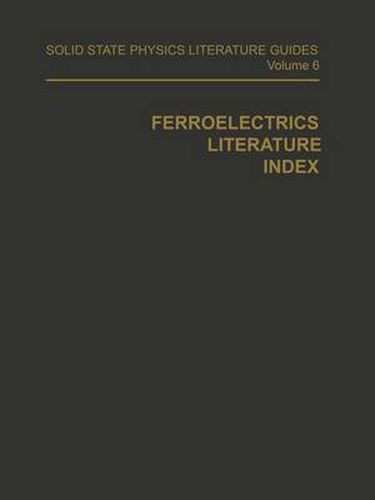Readings Newsletter
Become a Readings Member to make your shopping experience even easier.
Sign in or sign up for free!
You’re not far away from qualifying for FREE standard shipping within Australia
You’ve qualified for FREE standard shipping within Australia
The cart is loading…






This title is printed to order. This book may have been self-published. If so, we cannot guarantee the quality of the content. In the main most books will have gone through the editing process however some may not. We therefore suggest that you be aware of this before ordering this book. If in doubt check either the author or publisher’s details as we are unable to accept any returns unless they are faulty. Please contact us if you have any questions.
Research on ferroelectricity and ferroelectric materials started in 1920 with the discovery by Valasek that the variation of spontaneous polarization in Rochelle salt with sign and magnitude of an applied electric field traced a complete and reproducible hysteresis loop. Activity in the field was sporadic until 1935, when Busch and co-workers announced the observation of similar behavior in potassium dihydrogen phosphate and related compounds. Progress thereafter continued at a modest level with the undertaking of some theoretical as well as further experimental studies. In 1944, von Hippel and co-workers discovered ferroelectricity in barium titanate. The technological importance of ceramic barium titanate and other perovskites led to an upsurge of interest, with many new ferroelectrics being identified in the following decade. By 1967, about 2000 papers on various aspects of ferroelectricity had been published. The bulk of this widely dispersed literature was concerned with the experimental measurement of dielectric, crystallographic, thermal, electromechanical, elastic, optical, and magnetic properties. A critical and excellently organized cpmpilation based on these data appeared in 1969 with the publica tion of Landolt-Bornstein, Volume 111/3. This superb tabulation gave instant access to the results in the literature on nearly 450 pure substances and solid solutions of ferroelectric and antiferroelectric materials. Continuing interest in ferroelectrics, spurred by the growing importance of electrooptic crystals, resulted in the publication of almost as many additional papers by the end of 1969 as had been surveyed in Landolt-Bornstein.
$9.00 standard shipping within Australia
FREE standard shipping within Australia for orders over $100.00
Express & International shipping calculated at checkout
This title is printed to order. This book may have been self-published. If so, we cannot guarantee the quality of the content. In the main most books will have gone through the editing process however some may not. We therefore suggest that you be aware of this before ordering this book. If in doubt check either the author or publisher’s details as we are unable to accept any returns unless they are faulty. Please contact us if you have any questions.
Research on ferroelectricity and ferroelectric materials started in 1920 with the discovery by Valasek that the variation of spontaneous polarization in Rochelle salt with sign and magnitude of an applied electric field traced a complete and reproducible hysteresis loop. Activity in the field was sporadic until 1935, when Busch and co-workers announced the observation of similar behavior in potassium dihydrogen phosphate and related compounds. Progress thereafter continued at a modest level with the undertaking of some theoretical as well as further experimental studies. In 1944, von Hippel and co-workers discovered ferroelectricity in barium titanate. The technological importance of ceramic barium titanate and other perovskites led to an upsurge of interest, with many new ferroelectrics being identified in the following decade. By 1967, about 2000 papers on various aspects of ferroelectricity had been published. The bulk of this widely dispersed literature was concerned with the experimental measurement of dielectric, crystallographic, thermal, electromechanical, elastic, optical, and magnetic properties. A critical and excellently organized cpmpilation based on these data appeared in 1969 with the publica tion of Landolt-Bornstein, Volume 111/3. This superb tabulation gave instant access to the results in the literature on nearly 450 pure substances and solid solutions of ferroelectric and antiferroelectric materials. Continuing interest in ferroelectrics, spurred by the growing importance of electrooptic crystals, resulted in the publication of almost as many additional papers by the end of 1969 as had been surveyed in Landolt-Bornstein.